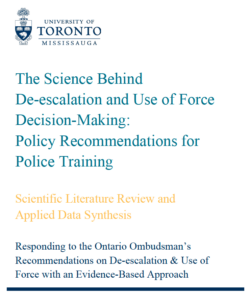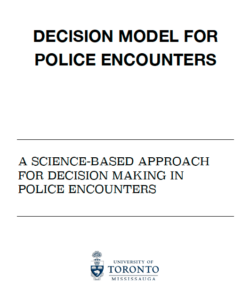The Science Behind De-escalation and Use of Force Decision-Making
On June 29th, 2016 Ombudsman Paul Dubé published a report titled “A Matter of Life and Death: Investigation into the direction provided by the Ministry of Community Safety and Correctional Services (MCSCS) to Ontario’s police services for de-escalation of conflict situations.”
In this report, Ombudsman Dubé recommended that MCSCS address training standards on de-escalation and use of force for police in Ontario. The report also recommended the development of a Use of Force model that clearly identified de-escalation options and that was understandable to the public. Our University of Toronto (UofT) research team was engaged to conduct two research projects to advise the Ministry’s response to the Ombudsman’s recommendations.
On June 30th 2017, the UofT research team submitted to MCSCS a comprehensive evidence-based report outlining the current state of de-escalation and Use of Force training for police in Ontario. This report also includes recommendations for incorporating scientific knowledge into revised de-escalation and Use of Force training. Click here for the executive summary and recommendations for action.
The Decision Model for Police Encounters
On August 30th 2018, the UofT team submitted to MCSCS a second report, which includes an evidence-based ‘Critical Decision Making Model’ to guide training police in de-escalation and Use of Force decision-making in response to the Ombudsman’s recommendations. This model was designed through the combined efforts of scientists, police experts, visual graphic designers, and community stakeholders. The new Critical Decision Making Model emphasizes public safety and de-escalation above all other options. In addition, the model can be trained and assessed for its effectiveness as a tool for guiding all police decisions, not just those necessitating force options. The Decision Model is published on page 1417 of this article and all future references to this model should cite the follow: Huey L, Andersen J, Bennell C, Ann Campbell M, Koziarski J, and Vaughan AD. (2021). Caught in the currents: evaluating the evidence for common downstream police response interventions in calls involving persons with mental illness. FACETS 6: 1409–1445. doi:10.1139/facets-2021-0055

